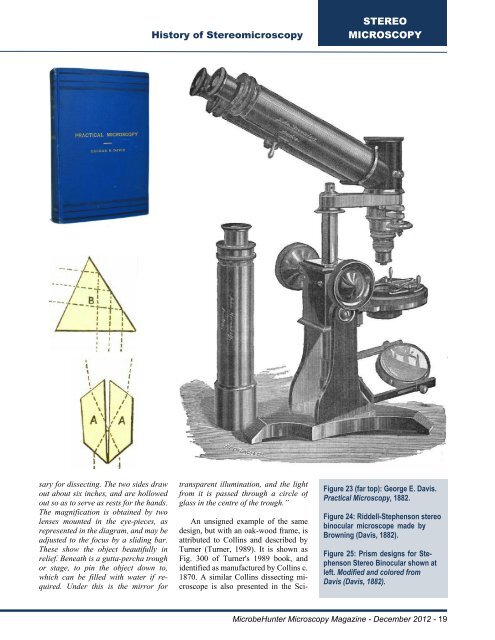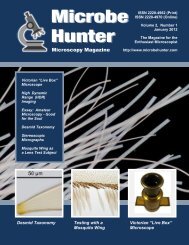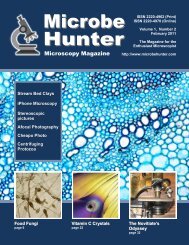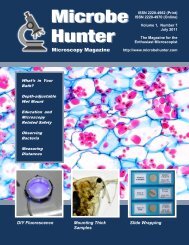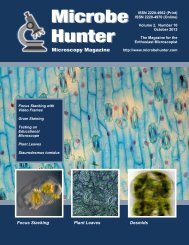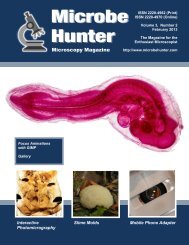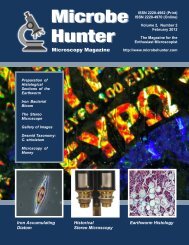STEREOMICROSCOPYHistory of StereomicroscopyFigure 21 (left): Figure 21. A representationof Riddell's original microscope,slightly software enhanced,by the author (Carpenter, 1901)Figure 22 (top): Riddell's TrapezoidalPrisms (Carpenter, 1901), modifiedhere for illustration.for devices that differed considerablyfrom the original stereographoscopes.As one example, a "stereo-graphoscope"patented in the USA in the late1880s is shown in Fig. 18. As can beseen, it is closer to a conventional stereoviewer than the stereographoscopes discussedabove. Its distinguishing featurewas its brass mounted lenses that couldbe rotated to view non-stereo images.Stereo viewers were the most ubiquitoussimple stereo binocular microscopesever made. As with the modernGreenough stereo <strong>com</strong>pound microscope,see later in this paper, they viewtwo slightly dissimilar images, that arethen merged by the brain to form a 3Dobject.Binocular DissectingMicroscopesThe advances in stereo vision werenot restricted to stereo viewers. Theywere extended to the development ofbinocular microscopes including examplesby Riddell, Stephenson, Wenham,and Collins. The smallest and least<strong>com</strong>plex of these, although not chronologicallythe earliest, was possibly thesimple Collins' Lawson Binocular DissectingMicroscope. This is describedin Hogg (Hogg, 1867), and picturedhere as Fig. 19.“This instrument is intended to supplya want, often felt in anatomical andbotanical investigations, when only amoderate magnifying power is required.In consequence of using both eyes itcan be worked with for a length of timewith great <strong>com</strong>fort. A large range offield is obtained, and plenty of room forworking. It consists of a neat oblongFrench-polished mahogany box, measuring,when closed, 6 in. by 4 in., fig.52. The top and front let down by hinges,and on the inside of them are fittedthe scissors, needles, and knives neces-18 - <strong>MicrobeHunter</strong> Microscopy Magazine - <strong>December</strong> <strong>2012</strong>
History of StereomicroscopySTEREOMICROSCOPYsary for dissecting. The two sides drawout about six inches, and are hollowedout so as to serve as rests for the hands.The magnification is obtained by twolenses mounted in the eye-pieces, asrepresented in the diagram, and may beadjusted to the focus by a sliding bar.These show the object beautifully inrelief. Beneath is a gutta-percha troughor stage, to pin the object down to,which can be filled with water if required.Under this is the mirror fortransparent illumination, and the lightfrom it is passed through a circle ofglass in the centre of the trough.”An unsigned example of the samedesign, but with an oak-wood frame, isattributed to Collins and described byTurner (Turner, 1989). It is shown asFig. 300 of Turner's 1989 book, andidentified as manufactured by Collins c.1870. A similar Collins dissecting microscopeis also presented in the Sci-Figure 23 (far top): George E. Davis.Practical Microscopy, 1882.Figure 24: Riddell-Stephenson stereobinocular microscope made byBrowning (Davis, 1882).Figure 25: Prism designs for StephensonStereo Binocular shown atleft. Modified and colored fromDavis (Davis, 1882).<strong>MicrobeHunter</strong> Microscopy Magazine - <strong>December</strong> <strong>2012</strong> - 19


